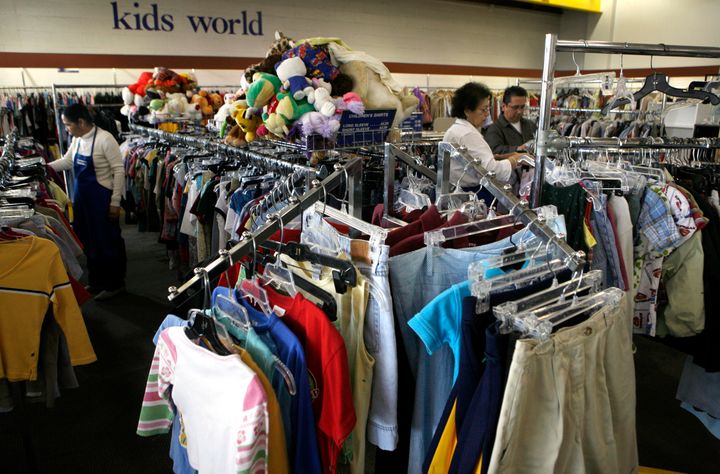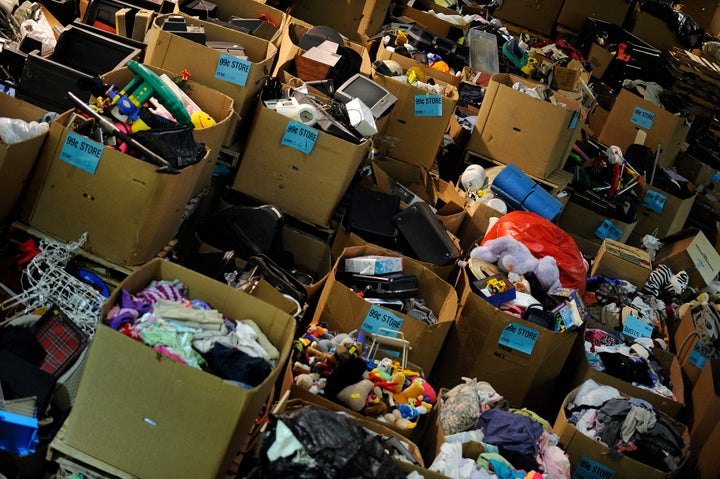
Giving away used clothes may sound simple: You drop them off at a donation center, and then they’re sold to somebody who can re-use them. Right?
Not quite. In reality, donated clothing often takes a much longer journey before meeting its ultimate fate. In the end, it may get re-sold. But it also may end up in the trash, joining the approximately 12.8 million tons of American textile waste that was sent to landfills during 2013. And that benefits no one.
Goodwill is one of the biggest U.S. landing points for donated clothes: Stores in New York and New Jersey alone collected more than 85.7 million pounds of textile donations last year, Jose Medellin, director of communications for Goodwill NY/NJ, told HuffPost. And his Goodwill region is just one of 164 regional Goodwill organizations across the U.S. and Canada.
As you’re probably starting to realize, it takes a ton of effort to guide your clothes from the Goodwill donation bin to their final resting place. Knowing how Goodwill works can help you make smarter decisions when deciding if another jeans purchase is really worth it for you, for the donations staff and for the environment.
Step 1: The Goodwill retail store
Goodwill operates more than 3,200 individual stores, Kyle Stewart, director of donated goods retail, told HuffPost. When you donate a bag of clothing at a store, workers most likely parse through it to determine what can be sold and what can’t: Wet or mildew-y clothes are eliminated, but everything else is fair game.
Ray Tellez, the vice president of retail operations for Goodwill Southern California, said stores in his region track how long each piece of clothing has been on the retail floor. If an item doesn’t sell within four weeks, it’s sent onward in the process.

Step 2: A Goodwill outlet
Yup, even Goodwill has outlets. Whatever doesn’t sell on the retail floor goes to a separate “Buy the Pound” outlet store or a 99 cent Goodwill store. Prices are kept ultra-low to encourage purchases, Tellez said.
At these stores, “the goal is to liquidate,” he told HuffPost. “We want to try and keep as much out of the landfill as possible.”
Each regional Goodwill organization may go about this process slightly differently. You can contact your regional Goodwill headquarters to learn more.


Step 3: Auction
Whatever isn’t sold in outlets moves on to Goodwill auctions, live events where attendees bid on bins of donated items without knowing precisely what’s inside. An auction bin might sell for as low as $35, which is a stellar value, according to Tellez.
Step 4: Textile Recyclers
Then comes the big move: If clothes weren’t able to sell in those first three stages of the process, Goodwill sends them to textile recycling organizations, Stewart said.
S.M.A.R.T., for example, is a trade association whose independent member businesses work to recycle textiles. On average, 45 percent of clothing that makes it to S.M.A.R.T. is either re-sold into the U.S. used clothing industry or sent overseas into markets with more demand, spokesperson Kathy Walsh told HuffPost.
But this isn’t necessarily a good thing. Obviously, re-selling clothes into the U.S. secondhand market just encourages them to make the cycle all over again. And sending clothes overseas can majorly hinder the textile industries in developing countries, robbing locals of jobs and income.
Beyond that, 30 percent of donated clothes at S.M.A.R.T. get cut into rags for industrial use, and 20 percent is processed into a soft fiber filling for furniture, home insulation, car sound-proofing and more.
But what about landfills?
If S.M.A.R.T. recyclers find clothes that are wet, moldy or contaminated, they send them to landfills, Walsh said. The amount they send is small ― just five percent of all donations ― but it all adds up to the ridiculous amount of clothing waste in landfills nationwide.
According to Walsh, nearly 95 percent of all clothing waste could be reused and recycled. We just aren’t disposing of it properly.
For starters, you should never, ever throw your clothes in the garbage, Medellin says. Instead, take them to a Goodwill or other donation center. If they’re wet, moldy or otherwise hazardous, then contact your city’s sanitation department and ask how best to dispose of them.
Of course, the easiest way to prevent clothing waste is to avoid buying clothes you don’t need. Keep a clean closet, and a cleaner planet will be waiting for you later.
CORRECTION: A previous version of this post stated that Americans sent 12 million pounds of textile waste to landfills in 2013. In fact, the number is much higher, at approximately 12.8 million tons.
More stories like this: